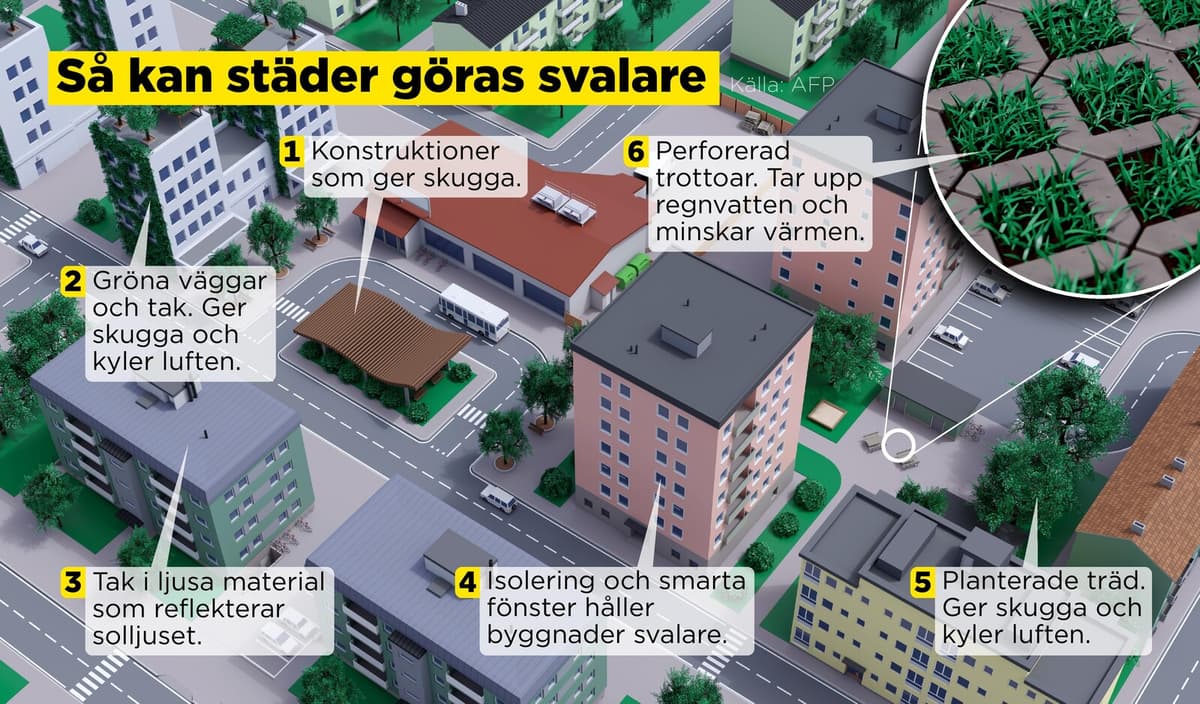Increasing temperatures were not considered in the planning when the world's megacities were growing. Many of them are now at risk of being transformed into ovens – and it is the most vulnerable part of the population that is hardest hit, warns Eleni Myrivili, heat chief at the UN's housing and building issues program.
Cities today are heat traps and built for other types of temperatures, for a different climate. We need to understand and completely change our perspective on how we renovate and develop new areas, she says to AFP.
Shade is decisive
In the Greek capital Athens, the UN has been working to categorize extreme heat. Different levels of heatwaves should trigger different types of guidelines and measures from a political perspective.
We have also created heat campaigns, so that people understand how dangerous heat can be for their health and what they should do during heatwaves, says Eleni Myrivili.
Another aspect is to ensure that the population has access to cooling shade, especially near train and bus stations, she explains. There, it is important that the buildings that create shade have special properties that make them not absorb heat when people stand right under them.
The world must adapt to a completely different climate in the coming decades, notes Eleni Myrivili.
We must prioritize shade, wind, and water, and, of course, nature.
Even Swedish cities are preparing for a warmer climate. In Stockholm, the focus is on planting more street trees, says Malinda Flodman at the Traffic Office in Stockholm Municipality.
You look at how much canopy coverage you have. The more trees, the more shade. It's good both for lowering the temperature locally on the street during heatwaves, but also for insects and animals, she says.
Air conditioning?
To succeed in the changes, more professional groups such as landscape architects, ecologists, and foresters must contribute with their knowledge, according to Myrivili.
She highlights water as a particularly decisive element – which can either help or harm. An example is air conditioning, which can be life-saving for the most vulnerable, but must be used with great caution.
We cannot air condition our way out of this mess we've created, because air conditioning is a very selfish way to handle extreme heat, says Myrivili.
You cool down your own little space, while blowing out more warm air in public spaces.
The picture is shared by Izabella Rosengren, biologist and science journalist, who has traveled around the world and investigated how different countries and cultures deal with extreme heat.
Air conditioning is a short-term solution because it consumes energy that is often not renewable. In that way, you actually contribute to the enhanced greenhouse effect instead of mitigating it, she says.
Countries that have lived with a hot climate for a long time are better at handling increased temperatures, she emphasizes.
There are extreme cases like in the middle of Australia where it's very hot and they've built cities in the mountains. In North Africa, they've had cultures that have lived under the ground or built houses partially underground because it's cooler there, says Izabella Rosengren and continues:
And why not? It's actually how you should do it, look at those who have experienced this before.
National measures are needed
She highlights Italy and the Middle East as further examples where people previously built houses in a special way: with clay instead of concrete as a material, a large tree on the yard that all rooms led to, and special wind catchers that brought in cool air from above.
Today, we've completely gone away from that with the quick fix that we can air condition everything. Now we've built everything with glass, which makes us build a greenhouse that we have to spend enormous amounts of energy on, to keep the buildings at a temperature that is habitable, says Izabella Rosengren.
One of the cities she has visited as a journalist is Athens. There, she met Eleni Myrivili, who was then employed as heat chief, the first in a European capital.
It's a person who is responsible for coming up with measures to lower the temperature in a city. The proposed measures are not very popular because they complicate things by banning car traffic and the like, says Izabella Rosengren.
Local measures can work on the microclimate – but to lower the global temperature, it's not enough to plant many trees and drive less on the city level, she notes.
If you want to lower the global average temperature, you need much bigger things. Then you also need national heat chiefs.
Jenny Martorell/TT
Facts: Record heat 2024
TT
In 2024, the population in southeastern Europe was hit by an average of 37.3 days of strong heat stress, i.e. a perceived temperature of over 32 degrees. So many days have never been recorded on a year since the calculations started in 1950. The same applies to tropical nights, temperatures of over 20 degrees during a whole night, which in 2024 were 14.5 in southeastern Europe.
To calculate perceived temperature, you take into account actual temperature, humidity, and wind speed.
Source: Copernicus





